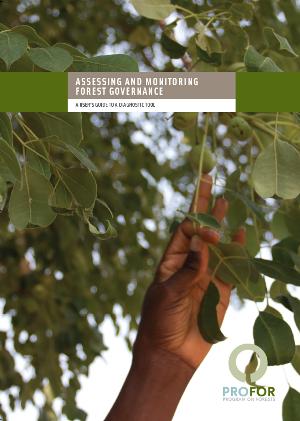
Share
Attachments
Governance-RDC_Rapport-23jan 2013_1.pdf
Liberia_Assessment of key governance issues for REDD+_2.pdf
ETAT DE LA GOUVERNANCE FORESTIERE 2012_1.pdf
ForestGovernanceFramework_0_1.pdf
AssessingMonitoringForestGovernance-guide_2.pdf
Download
Field Notes: The Journey of Forest Governance
Authors/Partners
Nalin Kishor and Kenneth Rosenbaum
Assessing and Monitoring Forest Governance
CHALLENGE
In 2009 a World Bank report called Roots for Good Forest Outcomes provided the framework for a comprehensive look at forest governance in terms of five building blocks and their principal components and subcomponents. As such, it provided a better insight into what constitutes “ideal” forest governance.
The next step was to develop a simple and actionable governance diagnostic tool which would help benchmark and pinpoint areas requiring reform, at a time when international initiatives such as FLEGT-VPA and REDD+ are putting pressure on countries to improve governance in the forestry sector.
A good diagnostic tool can establish a baseline for forest governance in specific countries and help identify areas for reform in a non-prescriptive manner, building consensus among stakeholders.
APPROACH
Along with the World Bank, several agencies and NGOs (World Resources Institute, Global Witness, Transparency International and Chatham House for example) have begun developing forest governance monitoring tools. Although these initiatives have been developed for different purposes and with different end users in mind, preliminary comparative analysis of these initiatives has shown that there is considerable concordance.
To avoid duplication of efforts, PROFOR, the World Bank and FAO organized a symposium in Stockholm on 13-14 September 2010 during which various forest agencies agreed to work toward defining a common framework of principles and criteria for assessing and monitoring forest governance. This followed field testing of governance-related questions in Uganda among public servants, academics, journalists, parliamentarians and private entrepreneurs took place in Kampala on 15-16 June, 2010.
In May 2011, an experts' meeting convened to discuss a new document drafted with support from FAO, PROFOR and the European Forest Institute, entitled Framework for Assessing and Monitoring Forest Governance (available on this page). Field testing of this approach in Burkina Faso (with PROFOR support) and by partners in Kenya (Indufor) and the Russian Federation (World Bank) helped define and refine a forest governance diagnostic tool.
RESULTS
This work resulted in a publication: Assessing and Monitoring Forest Governance: A user's guide to a diagnostic tool (available on this page) published by PROFOR in June 2012.
- The tool consists of a set of indicators and a protocol for scoring the indicators. The indicators are in the form of multiple-choice questions about aspects of forest governance. Some cover general features of governance, some touch on specifics, and some serve as proxies for factors that are difficult to assess directly. Taken as a whole, the tool examines forest sector governance broadly, serving as a self-assessment to identify areas deserving improvement.
- Recognizing that local involvement is key to successful reform, the tool’s protocol uses a workshop format, where stakeholders meet to discuss governance and try to come to agreement on scoring the indicators. Putting assessment in the hands of stakeholders promotes discussion, identifies areas of consensus, and builds momentum for change.
- The tool will serve countries or their subdivisions that want to improve governance. The initial diagnosis can be a starting point from which to set priorities for reform, to target some areas for deeper study, or to track the progress of reform efforts. A convincing assessment can even contribute to the desire for reform.
- The tool is flexible, relatively inexpensive to use, and adaptable to many contexts. It can be rolled out in a matter of months.
- Since the guide was published, the approach was used in Madagascar by the German aid agency GIZ and Alliance Voahary Gasy for example. In October 2012, a group of experts selected 63 indicators that seemed pertinent to the country context and organized a two day workshop during which government, private sector and civil society actors participated in different working groups, and produced an overall diagnostic of forest governance in the country. It was also used in November 2012 in the Democratic Republic of Congo (with support from USAID.CARPE, IUCN, FCPF) and in Liberia in April 2013 (with support from FCPF). Workshop reports are available on this page.
For stories and updates on related activities, follow us on twitter and facebook, or subscribe to our mailing list for regular updates.
Author : Nalin Kishor and Kenneth Rosenbaum
Last Updated : 06-16-2024








